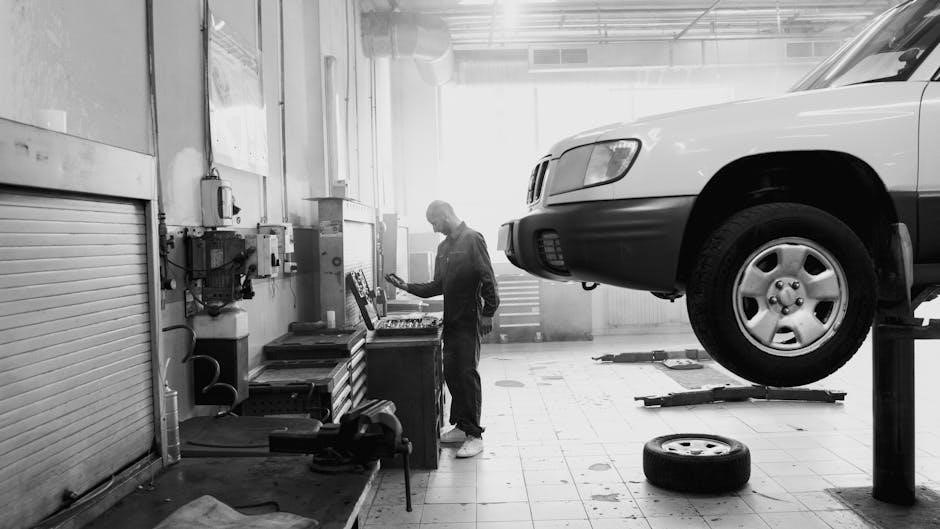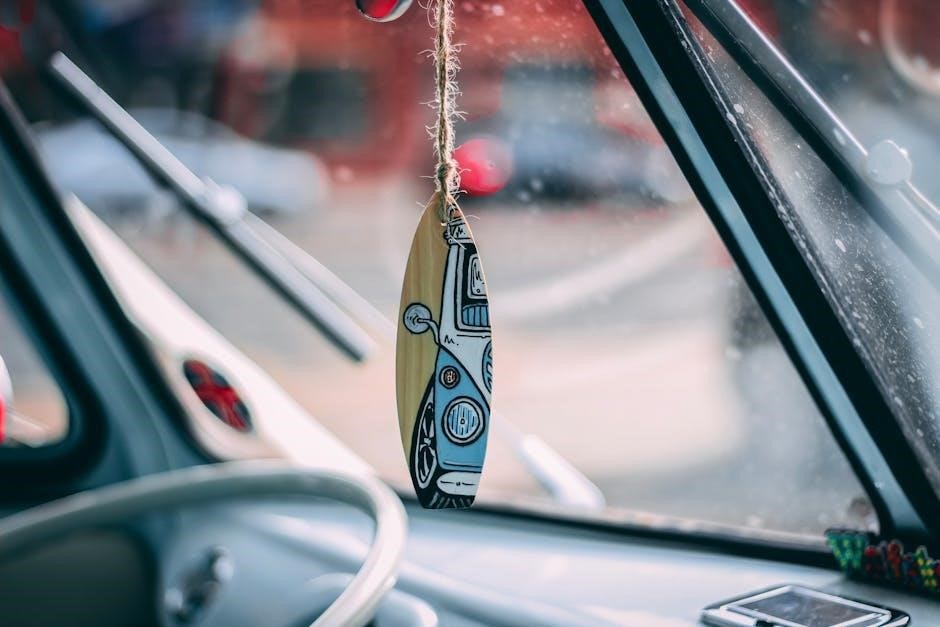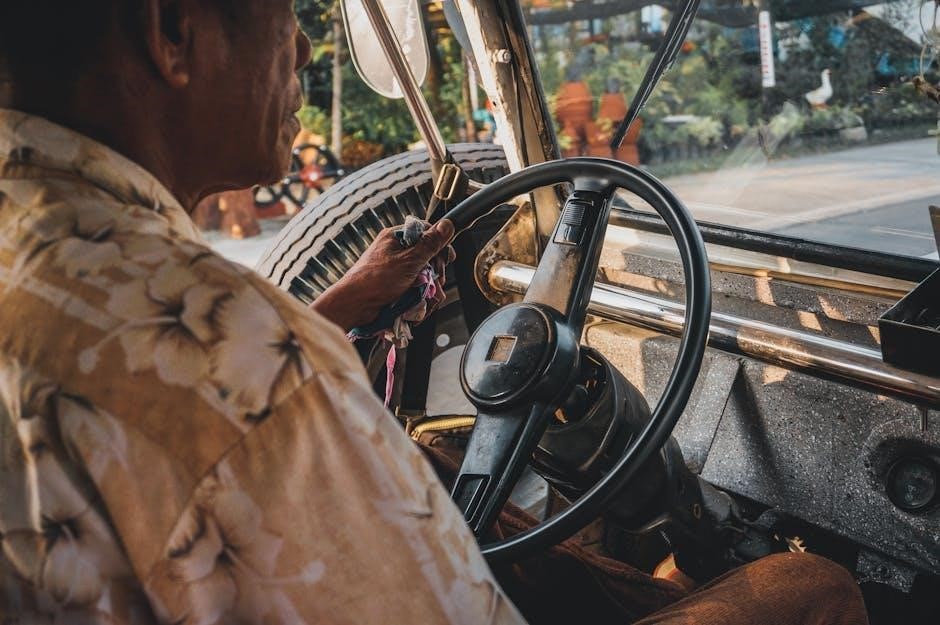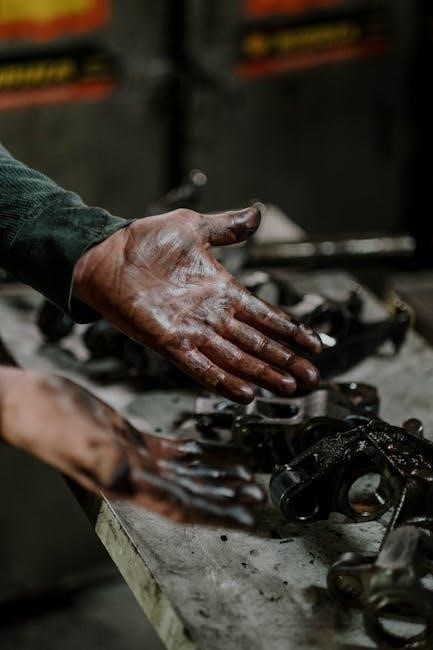Manual cars, known for their engaging driving experience, have long been favored by enthusiasts. They offer precise control, making them popular among drivers who value performance and connection.
Popularity of Manual Transmission Cars
Manual transmission cars have maintained a loyal following despite the rise of automatic vehicles. Drivers often choose manuals for their tactile driving experience, fuel efficiency, and cost-effectiveness. In regions like Europe and Japan, manuals dominate due to narrow roads and fuel prices, fostering a culture of precision driving. Enthusiasts appreciate the control and connection to the vehicle, making manuals a symbol of passion and skill. While automatics are gaining ground globally, manuals remain popular among purists. This preference highlights the emotional bond drivers have with manual cars, emphasizing the joy of driving over convenience.
Why Manual Cars Are Preferred by Enthusiasts
Manual cars captivate driving enthusiasts due to their direct connection to the road, offering a tactile and immersive experience. The ability to control gear shifts allows for precise acceleration and deceleration, enhancing performance. Enthusiasts value the mechanical interaction, as it fosters a deeper bond with the vehicle. Manual transmissions are often lighter and more fuel-efficient, contributing to better handling and responsiveness. Additionally, the emotional satisfaction of mastering a manual gearbox creates a sense of accomplishment. For purists, the manual transmission embodies the essence of driving, making it a preferred choice for those who prioritize engagement and control behind the wheel.

History of Manual Cars
Manual cars trace their origins to the early 20th century, evolving from basic gear systems to refined transmissions. They became synonymous with performance and driver control.
Evolution of Manual Transmission
Manual transmissions have evolved significantly since their inception in the early 20th century. Early systems were rudimentary, with non-synchronized gears requiring double-clutching. The 1920s introduced synchromesh technology, enabling smoother shifting. By the 1980s, advancements in materials and engineering led to lighter, more durable transmissions. Modern manual transmissions feature precise gearing, reduced weight, and improved efficiency, enhancing performance and driver engagement. These innovations have been pivotal in creating high-performance manual cars that deliver exceptional speed and handling, making them a favorite among driving enthusiasts and collectors alike.
Key Milestones in Manual Car Development
The development of manual cars has been marked by significant milestones. The first manual transmission appeared in the early 20th century, with the Ford Model T popularizing the concept. The 1920s saw the introduction of synchromesh technology, reducing gear grinding. By the 1960s and 1970s, manual transmissions became synonymous with performance, as seen in iconic sports cars like the Porsche 911 and Chevrolet Corvette. The 1980s brought advancements in materials and design, leading to smoother, more durable systems. In the 1990s, precise engineering enabled faster shifting and better fuel efficiency. Today, manual transmissions remain a symbol of driving purity, with modern cars like the Honda Civic Type R and Toyota GR 86 continuing the legacy.

Benefits of Manual Cars

Manual cars offer lower costs, better fuel efficiency, and increased driver engagement, making them a preferred choice for both economical and performance-driven enthusiasts worldwide.
Better Fuel Efficiency
Manual cars typically offer better fuel efficiency compared to automatics due to their simpler design and reduced parasitic loss. Drivers can optimize gear shifts to maximize mileage, especially in city driving. This connection between driver input and engine response encourages more mindful driving habits, further enhancing fuel economy. Even among the fastest manual cars, such as the Honda Civic Type R or Toyota GR 86, fuel efficiency remains a notable advantage. This makes manual transmissions a practical choice for enthusiasts who value performance without compromising on economy. The direct control over gears ensures that power is used efficiently, translating to better miles per gallon and lower operating costs over time.
Increased Driver Engagement
Manual cars foster a deeper connection between the driver and the vehicle, requiring active participation in gear shifting and clutch operation. This hands-on engagement heightens the driving experience, making it more immersive and rewarding. Drivers must anticipate and respond to road conditions, fostering a sense of control and precision. The physical interaction with the car’s mechanics enhances focus and enjoyment, especially in spirited driving scenarios. For enthusiasts, the tactile feedback of shifting gears is unparalleled, creating a bond between the driver and the machine. This level of involvement is a key reason why manual cars remain popular among those who value the art of driving over convenience. The connection to the road is unmatched, making every journey more engaging and memorable for drivers who appreciate the thrill of manual control.
Cost-Effectiveness
Manual cars are often more affordable to purchase and maintain compared to their automatic counterparts. The simpler design of manual transmissions reduces production costs, making them more accessible to budget-conscious buyers. Additionally, manual cars typically require less expensive repairs and replacements, as they have fewer complex components. Insurance premiums for manual vehicles are also generally lower, further enhancing their cost-effectiveness. Fuel efficiency is another advantage, as manual cars often achieve better mileage, saving drivers money on gas over time. These financial benefits, combined with their durability, make manual cars a practical choice for many drivers seeking a cost-effective yet engaging driving experience.

Future of Manual Cars
Despite rising automation, manual cars remain popular among driving purists. Their tactile experience and emotional connection continue to attract enthusiasts, ensuring their niche in the automotive market.
Rise of Automatic and Autonomous Vehicles
The automotive industry is witnessing a significant shift toward automatic and autonomous vehicles, driven by technological advancements and changing consumer preferences. Automatic transmissions now dominate the market, offering convenience and ease of use. Meanwhile, autonomous vehicles promise enhanced safety, reduced traffic congestion, and improved mobility for the elderly and disabled. These innovations are reshaping the driving experience, prioritizing comfort and efficiency over manual control. Despite this trend, manual cars retain a loyal following among driving enthusiasts who cherish the tactile connection and precision they provide. The rise of automation, however, signals a potential decline in the popularity of manual transmissions, as modern drivers increasingly favor hands-free and stress-free driving options.
Manual Cars in the Age of Automation
Despite the growing dominance of automatic and autonomous vehicles, manual cars continue to hold a special place in the automotive world. Enthusiasts argue that manual transmissions offer a unique driving experience, fostering a deeper connection between the driver and the vehicle. The tactile sensation of shifting gears and the control it provides remain irreplaceable for many. While automation prioritizes convenience, manual cars cater to purists who value driving as an art form. Even as technology advances, manual cars are likely to persist in niche markets, appealing to those who cherish the thrill of hands-on driving. Their enduring appeal highlights the emotional and cultural significance of manual transmissions in a world increasingly dominated by automation.

From sleek sports cars to powerful performance vehicles, the fastest manual cars deliver unmatched speed and driving thrill, appealing to enthusiasts who crave control and connection.
Porsche 911 GT3
The Porsche 911 GT3 is a pinnacle of performance, blending raw power with precise handling. Its naturally aspirated flat-six engine delivers exhilarating acceleration, with 502 horsepower and 346 lb-ft of torque. The 7-speed manual transmission enhances the driving experience, offering a direct connection to the road. Capable of 0-60 mph in just 3.8 seconds and a top speed of 199 mph, the GT3 is a track-ready machine. Its lightweight design and aerodynamic features ensure exceptional agility, making it a favorite among enthusiasts. The GT3’s manual gearbox is praised for its tactile feedback and responsiveness, providing a more immersive drive. With its rich racing heritage and refined engineering, the Porsche 911 GT3 remains a symbol of driving excellence, appealing to purists who crave the thrill of a manual transmission.
Chevrolet Corvette Stingray
The Chevrolet Corvette Stingray is a powerhouse of American engineering, offering a thrilling driving experience with its manual transmission. Equipped with a 6.2L V8 engine, it produces 460 horsepower and 465 lb-ft of torque. The 8-speed dual-clutch automatic is optional, but the 7-speed manual is favored for its tactile feedback and driver engagement. Capable of 0-60 mph in 3.8 seconds, the Stingray combines raw power with precision. Its lightweight design and aerodynamic features enhance handling, making it a standout on both road and track. The manual gearbox allows drivers to fully exploit the engine’s potential, delivering a more immersive and connected driving experience. With its iconic design and exceptional performance, the Corvette Stingray remains a symbol of automotive excellence, appealing to enthusiasts who cherish the art of manual driving.
BMW M3
The BMW M3 is a high-performance icon, blending power with precision. Its 3.0L twin-turbo inline-6 engine delivers 473 horsepower and 406 lb-ft of torque in base models. The optional manual transmission enhances driver engagement, offering a tactile connection to the road. With a 0-60 mph time of 4.1 seconds, the M3 combines speed and agility. Its rear-wheel-drive layout and adaptive suspension provide exceptional handling, making it a favorite on both streets and tracks. The manual gearbox allows drivers to fully utilize the engine’s capabilities, delivering a more immersive experience. As a symbol of BMW’s motorsport heritage, the M3 continues to captivate enthusiasts who value performance and driving purity, solidifying its place among the fastest manual cars available today.
Nissan GT-R (Manual Option)
The Nissan GT-R, with its manual transmission option, stands as a testament to high-performance driving. Equipped with a 3.8L twin-turbo V6 engine, it produces 565 horsepower and 467 lb-ft of torque. The optional 6-speed manual gearbox enhances driving engagement, allowing precise control over the GT-R’s immense power. Its advanced all-wheel-drive system optimizes traction, enabling a 0-60 mph sprint in just 3.2 seconds. Enthusiasts appreciate the manual option for its tactile connection, making every shift feel deliberate and rewarding. The GT-R’s aerodynamic design and adaptive suspension further enhance its track capabilities. While it’s a brute in performance, the GT-R also offers refinement, making it a versatile choice for both road and track. Its legacy as a supercar icon continues to captivate drivers seeking raw power and mechanical connection.
Honda Civic Type R
The Honda Civic Type R is a high-performance hatchback renowned for its exceptional handling and power. Equipped with a 2.0L turbocharged inline-4 engine, it delivers 315 horsepower and 310 lb-ft of torque. The 6-speed manual transmission is a key feature, offering precise and responsive shifts that enhance the driving experience. Its lightweight chassis and adaptive dampers provide a balance of agility and stability, making it a favorite on both roads and racetracks. The Civic Type R’s aerodynamic design, including a prominent rear wing, improves downforce at high speeds. With a 0-60 mph time of just 5.1 seconds, it combines practicality with exhilarating performance. Enthusiasts praise its engaging manual gearbox and track-ready capabilities, solidifying its reputation as one of the fastest and most fun manual cars available.
Ford Mustang Shelby GT350
The Ford Mustang Shelby GT350 is a track-focused powerhouse designed for enthusiasts seeking raw performance. Powered by a 5.2L naturally aspirated V8 engine, it produces 529 horsepower and 429 lb-ft of torque. The 6-speed Tremec manual transmission is finely tuned for precise shifts, delivering an immersive driving experience. Its lightweight design, aerodynamic body, and MagneRide suspension system optimize handling and stability at high speeds. The GT350’s exhaust system, featuring a unique sound, adds to its aggressive character. With a 0-60 mph time of 4.2 seconds, it combines brute power with exceptional control. Drivers praise its responsiveness and connection to the road, making it a standout in the realm of fast manual cars. The Shelby GT350 embodies the spirit of performance driving, catering to those who crave adrenaline and precision.
Mazda MX-5 Miata
The Mazda MX-5 Miata is a lightweight, rear-wheel-drive roadster celebrated for its exceptional handling and driving dynamics. Equipped with a 2.0L inline-4 engine, it delivers 181 horsepower and 151 lb-ft of torque, paired with a precise 6-speed manual transmission. The MX-5 Miata’s compact design and near-perfect weight distribution make it a joy to drive, offering crisp steering and responsive acceleration. While not the fastest in terms of raw power, its agility and connection to the road create an unparalleled driving experience. Its popularity stems from its affordability, reliability, and timeless design, making it a favorite among driving purists. The MX-5 Miata proves that speed isn’t just about horsepower—it’s about how the car feels in your hands.
Subaru WRX STI
The Subaru WRX STI is a high-performance rally-bred sports car renowned for its all-wheel-drive system and manual transmission. Powered by a 2.5L turbocharged boxer engine, it produces 310 horsepower and 296 lb-ft of torque. The 6-speed manual gearbox offers precise shifts, while the Symmetrical AWD system enhances traction and control. Its chassis is tuned for agility, making it a favorite on both racetracks and winding roads. The STI’s rally heritage shines through its responsive handling and satisfying driver feedback. While it may not be the fastest in a straight line, its balance of power and grip makes it a standout in the world of manual performance cars. Enthusiasts praise its raw driving experience and capability in various conditions.
Toyota GR 86
The Toyota GR 86 is a lightweight, rear-wheel-drive sports car designed for driving purists. Equipped with a 2.4L naturally aspirated boxer engine, it delivers 228 horsepower and 184 lb-ft of torque. The 6-speed manual transmission provides smooth, precise shifts, enhancing the car’s engaging driving experience. Its balanced chassis and low center of gravity make it highly responsive, perfect for spirited driving or track days. While not the fastest car in a straight line, the GR 86 excels in handling and agility, making it a favorite among enthusiasts who value precision and fun over raw speed. Its affordable price and rear-wheel-drive layout further cement its reputation as a modern classic for manual car enthusiasts.
Volkswagen Golf GTI
The Volkswagen Golf GTI is a iconic hot hatch that combines performance with practicality. Its 2.0L turbocharged engine produces 241 horsepower and 273 lb-ft of torque, paired with a smooth 6-speed manual transmission. The GTI’s sport-tuned suspension and precise steering deliver sharp handling, making it a joy on twisty roads. Inside, it features a premium interior with supportive seats and modern tech. Despite its performance capabilities, the GTI remains a versatile daily driver. Its balance of power, efficiency, and affordability has made it a cult classic. For enthusiasts seeking a car that excels in both everyday driving and spirited adventures, the Golf GTI is a standout choice that blends heritage with modern engineering.

Ferrari 458 Italia
The Ferrari 458 Italia is a high-performance sports car renowned for its exceptional handling and powerful engine. Equipped with a 4.5L V8 engine, it delivers 562 horsepower and 398 lb-ft of torque. The 458 Italia is paired with a 6-speed manual transmission, offering a direct and engaging driving experience. Its lightweight design and aerodynamic bodywork enhance agility and speed, making it a favorite among driving purists. The car’s sleek exterior and luxurious interior further emphasize its status as a premium sports car.
With a top speed of 198 mph, the 458 Italia combines raw power with precision, making it one of the fastest manual cars on the road. Its legacy as a modern classic continues to captivate automotive enthusiasts worldwide.

Lamborghini Huracán
The Lamborghini Huracán is a high-performance supercar that combines powerful engineering with sleek design. Available with a 5.2L V10 engine, it produces 640 horsepower and 442 lb-ft of torque. While the Huracán is primarily equipped with an automatic transmission, certain special editions, such as the Huracán Performante, featured a manual transmission option, offering drivers a more tactile and engaging experience. Its all-wheel-drive system and lightweight chassis enhance stability and agility, making it a formidable contender on the track and road. The Huracán’s aerodynamic profile and advanced technology contribute to its exceptional speed, with a top speed of over 200 mph. This Italian marvel continues to impress enthusiasts with its blend of power, precision, and style.

Regional Preferences
Regional preferences for the fastest manual cars vary, with Europe favoring sporty models like the Porsche 911, the US leaning toward muscle cars like the Ford Mustang, and Japan embracing performance icons such as the Nissan GT-R, highlighting diverse driving cultures and preferences shaped by local road conditions and enthusiasts’ demands.
Fastest Manual Cars in Europe
In Europe, the fastest manual cars are highly prized for their blend of performance and driving precision. Models like the Porsche 911 GT3 and Chevrolet Corvette Stingray are favorites, offering exceptional acceleration and handling. The BMW M3 also stands out, delivering a perfect balance of power and agility. European drivers often favor cars with advanced aerodynamics and lightweight designs, which enhance speed and responsiveness on the continent’s winding roads. These vehicles are celebrated for their ability to combine raw power with a connected driving experience, making them icons among European car enthusiasts who value both speed and precision behind the wheel.
Fastest Manual Cars in the US
The US market boasts some of the fastest manual cars, blending power and precision. The Ford Mustang Shelby GT350 and Chevrolet Corvette Stingray are top contenders, delivering exceptional acceleration and agility. These models are celebrated for their robust engines and smooth manual transmissions, offering drivers a thrilling experience. American drivers often favor cars with high horsepower and rear-wheel drive, which enhance performance on both racetracks and open roads. The Camaro SS and Dodge Challenger also rank high, combining classic muscle with modern engineering. These vehicles embody the spirit of American automotive culture, prioritizing raw speed and driver engagement, making them favorites among enthusiasts who crave adrenaline-pumping drives.
Fastest Manual Cars in Japan
Japan is renowned for producing high-performance manual cars that combine precision engineering with exhilarating driving experiences. The Honda Civic Type R stands out as a benchmark, offering exceptional handling and power. Meanwhile, the Mazda MX-5 Miata is celebrated for its lightweight design and agile performance; Toyota’s GR 86 and Subaru’s BRZ are twin rear-wheel-drive sports cars that deliver crisp manual shifting and driver engagement. The Subaru WRX STI also shines with its all-wheel-drive system and rally-bred heritage. Japanese automakers emphasize balance, responsiveness, and driver connection, making their manual cars highly sought after by enthusiasts worldwide; These vehicles reflect Japan’s automotive culture, blending innovation with a passion for the driving experience.
Manual cars remain a symbol of driving purism, blending performance with driver engagement. Their legacy endures, captivating enthusiasts and shaping automotive culture globally.
Legacy of Manual Cars
Manual cars have left an indelible mark on automotive history, embodying a connection between driver and machine. Their enduring appeal lies in the tactile experience they offer, fostering a deeper bond with the road. Iconic models like the Porsche 911 GT3 and Honda Civic Type R showcase the heritage of manual transmissions, blending performance with nostalgia. These cars have cultivated a loyal following, inspiring generations of driving enthusiasts. Their influence extends beyond performance, shaping automotive culture and racing traditions. As automation rises, manual cars remain a testament to the joy of driving, ensuring their legacy endures in the hearts of purists and collectors alike.
Cultural Impact of Manual Cars
Manual cars have profoundly shaped automotive culture, becoming symbols of passion and skill. They are celebrated in racing, car enthusiasts’ communities, and popular media. Movies like Fast & Furious and video games often highlight manual cars, glorifying the connection between driver and vehicle. The tactile experience of shifting gears has inspired a devoted following, with events like track days and car meets fostering camaraderie. Brands like Porsche, Honda, and Ford have embedded manual transmissions into their identities, creating iconic models revered worldwide. This cultural significance extends beyond performance, representing a shared love for driving as an art form. Manual cars continue to inspire, ensuring their place in automotive history and enthusiast hearts.
Final Verdict

Manual cars have left an indelible mark on automotive history, blending performance, tradition, and driver engagement. Despite the rise of automatic and autonomous vehicles, manual transmissions remain a symbol of driving purism. Their cultural significance is evident in iconic models like the Porsche 911 GT3 and Honda Civic Type R, which embody the spirit of enthusiast driving. While the future may lean toward automation, manual cars will always hold a special place in the hearts of driving enthusiasts. They represent a connection to the road and a celebration of the art of driving. For those who value control, precision, and the joy of shifting gears, manual cars will forever be a timeless choice.
